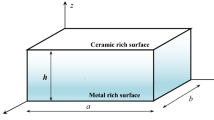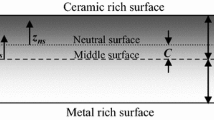Abstract
This work introduces a novel four-node quadrilateral finite element based on the strain approach and the first-order shear deformation theory for static and free vibration responses of functionally graded (FG) material plates. Material properties of the plate are assumed to be graded across the thickness direction by using a simple power law distribution of the volume fractions constituents. The developed element possesses five essential degrees of freedom per node. This element is obtained by the superposition of two strain-based elements where the first is a membrane with two degrees of freedom per node and the second is a Reissner–Mindlin plate that has three degrees of freedom per node. The displacements field of the proposed element which contains higher-order terms is based on assumed strain functions satisfying compatibility equations. The performance of the suggested element is evaluated through several tests and the obtained results are compared with available solutions from the literature. The results of the present element have proved excellent accuracy and efficiency in predicting bending and free vibration of FG plates.









Similar content being viewed by others
References
Yamanouchi, M., Koizumi, M., Hirai, T., Shiota, I. (eds.): In: Proceedings of 1st International Symposium Functionally Gradient Materials, Japan (1990)
Fukui, Y.: Fundamental investigation of functionally gradient material manufacturing system using centrifugal force. Int. J. Jpn. Soc. Mech. Eng. III(34), 144–148 (1991)
Praveen, G.N., Reddy, J.N.: Nonlinear transient thermoelastic analysis of functionally graded ceramic–metal plates. Int. J. Solids Struct. 35(33), 4457–4476 (1998)
Reddy, J.N.: Analysis of functionally graded plates. Int. J. Numer. Methods Eng. 47(1–3), 663–684 (2000)
Nguyen-Xuan, H., Tran, L.V., Nguyen-Thoi, T., Vu-Do, H.C.: Analysis of functionally graded plates using an edge-based smoothed finite element method. Compos. Struct. 93(11), 3019–3039 (2011)
Nguyen-Xuan, H., Tran, L.V., Thai, C.H., Nguyen-Thoi, T.: Analysis of functionally graded plates by an efficient finite element method with node-based strain smoothing. Thin Walled Struct. 54, 1–18 (2012)
Natarajan, S., Ferreira, A.J.M., Bordas, S., Carrera, E., Cinefra, M., Zenkour, A.M.: Analysis of functionally graded material plates using triangular elements with cell-based smoothed discrete shear gap method. Math. Probl. Eng. (2014). https://doi.org/10.1155/2014/247932
Singha, M.K., Prakash, T., Ganapathi, M.: Finite element analysis of functionally graded plates under transverse load. Finite Elem. Anal. Des. 47(4), 453–460 (2011)
Thai, H.T., Choi, D.H.: Finite element formulation of various four unknown shear deformation theories for functionally graded plates. Finite Elem. Anal. Des. 75(1), 50–61 (2013)
Moita, J.S., Correia, V.F., Soares, C.M.M., Herskovits, J.: Higher-order finite element models for the static linear and nonlinear behaviour of functionally graded material plate–shell structures. Compos. Struct. 212(15), 465–475 (2019)
Tati, A.: A five unknowns high order shear deformation finite element model for functionally graded plates bending behavior analysis. J. Braz. Soc. Mech. Sci. Eng. 43(1), 1–14 (2021)
Tati, A.: Finite element analysis of thermal and mechanical buckling behavior of functionally graded plates. Arch. Appl. Mech. 91, 4571–4587 (2021)
Sadgui, A., Tati, A.: A novel trigonometric shear deformation theory for the buckling and free vibration analysis of functionally graded plates. Mech. Adv. Mater. Struct. (2021). https://doi.org/10.1080/15376494.2021.1983679
Ashwell, D.G., Sabir, A.B.: A new cylindrical shell finite element based on simple independent strain functions. Int. J. Mech. Sci. 14(3), 171–183 (1972)
Sabir, A.B., Sfendji, A.: Triangular and rectangular plane elasticity finite elements. Thin Walled Struct. 21(3), 225–232 (1995)
Djoudi, M.S., Bahai, H.: A cylindrical strain-based shell element for vibration analysis of shell structures. Finite Elem. Anal. Des. 40(13–14), 1947–1961 (2004)
Bouzidi, L., Belounar, L., Guerraiche, K.: Presentation of a new membrane strain-based finite element for static and dynamic analysis. Int. J. Struct. Eng. 10(1), 40–60 (2019)
Fortas, L., Belounar, L., Merzouki, T.: Formulation of a new finite element based on assumed strains for membrane structures. Int. J. Adv. Struct. Eng. 11, 9–18 (2019)
Khiouani, H.E., Belounar, L., Houhou, M.N.: A new three-dimensional sector element for circular curved structures analysis. J. Solid Mech. 12(1), 165–174 (2020)
Belounar, A.: Eléments finis membranaires et flexionnels à champ de déformation pour l’analyse des structures. mémoire de Doctorat, Université de Mohamed Khider-Biskra (2019)
Boussem, F., Belounar, L.: A plate bending Kirchhoff element based on assumed strain functions. J. Solid Mech. 12(4), 935–952 (2020)
Belarbi, M.T., Charif, A.: Développement d’un nouvel élément hexaédrique simple basé sur le modèle en déformation pour l’étude des plaques minces et épaisses. Rev. eur. élém. finis 8(2), 135–157 (1999)
Belounar, L., Guerraiche, K.: A new strain based brick element for plate bending. Alex. Eng. J. 53(1), 95–105 (2014)
Guerraiche, K., Belounar, L., Bouzidi, L.: A new eight nodes brick finite element based on the strain approach. J. Solid Mech. 10(1), 186–199 (2018)
Messai, A., Belounar, L., Merzouki, T.: Static and free vibration of plates with a strain based brick element. Eur. J. Comput. Mech. (2019). https://doi.org/10.1080/17797179.2018.1560845
Belounar, L., Guenfoud, M.: A new rectangular finite element based on the strain approach for plate bending. Thin Walled Struct. 43, 47–63 (2005)
Belounar, A., Benmebarek, S., Belounar, L.: Strain based triangular finite element for plate bending analysis. Mech. Adv. Mater. Struct. 27(8), 620–632 (2020)
Belounar, A., Benmebarek, S., Houhou, M.N., Belounar, L.: Static, free vibration, and buckling analysis of plates using strain-based Reissner-Mindlin elements. Int. J. Adv. Struct. Eng. 11, 211–230 (2019)
Belounar, A., Benmebarek, S., Houhou, M.N., Belounar, L.: Free vibration with Mindlin plate finite element based on the strain approach. J. Inst. Eng. India C 101(2), 331–346 (2020)
Boussem, F., Belounar, A., Belounar, L.: Assumed strain finite element for natural frequencies of bending plates. World J. Eng. (2021). https://doi.org/10.1108/WJE-02-2021-0114
Reddy, J.N.: Mechanics of Laminated Composite Plates and Shells Theory and Analysis, 2nd edn. CRC Press, New York (2004)
Valizadeh, N., Natarajan, S., Gonzalez-Estrada, O.A., Rabczuk, T., Bui, T.Q., Bordas, S.P.A.: NURBS-based finite element analysis of functionally graded plates: static bending, vibration, buckling and flutter. Compos. Struct. 99, 309–326 (2013)
Lee, Y.Y., Zhao, X., Liew, K.M.: Thermoelastic analysis of functionally graded plates using the element-free kp-Ritz method. Smart Mater. Struct. 18(3), 1–15 (2009)
Gilhooley, D.F., Batra, R.C., Xiao, J.R., McCarthy, M.A., Gillespie, J.W.: Analysis of thick functionally graded plates by using higher-order shear and normal deformable plate theory and MLPG method with radial basis functions. Comput. Struct. 80(4), 539–552 (2007)
Neves, A.M.A., Ferreira, A.J.M., Carrera, E., Roque, C.M.C., Cinefra, M., Jorge, R.M.N., Soares, C.M.M.: A quasi-3D sinusoidal shear deformation theory for the static and free vibration analysis of functionally graded plates. Composites B 43(2), 711–725 (2012)
Neves, A.M.A., Ferreira, A.J.M., Carrera, E., Cinefra, M., Roque, C.M.C., Jorge, R.M.N., Soares, C.M.M.: A quasi-3D hyperbolic shear deformation theory for the static and free vibration analysis of functionally graded plates. Compos. Struct. 94(5), 1814–1825 (2012)
Neves, A.M.A., Ferreira, A.J.M., Carrera, E., Cinefra, M., Roque, C.M.C., Jorge, R.M.N., Soares, C.M.M.: Static, free vibration and buckling analysis of isotropic and sandwich functionally graded plates using a quasi-3D higher-order shear deformation theory and a meshless technique. Composites B 44(1), 657–674 (2013)
Carrera, E., Brischetto, S., Cinefra, M., Soave, M.: Effects of thickness stretching in functionally graded plates and shells. Composites B 42(2), 123–133 (2011)
Carrera, E., Brischetto, S., Robaldo, A.: Variable kinematic model for the analysis of functionally graded material plates. AIAA J. 46(1), 194–203 (2008)
Matsunaga, H.: Free vibration and stability of functionally graded plates according to a 2D higher-order deformation theory. Compos. Struct. 82(4), 499–512 (2008)
Zhao, X., Lee, Y.Y., Liew, K.M.: Free vibration analysis of functionally graded plates using the element-free kp-Ritz method. J. Sound Vib. 319(3–5), 918–939 (2009)
Hosseini-Hashemi, S., Fadaee, M., Atashipour, S.R.: A new exact analytical approach for free vibration of Reissner-Mindlin functionally graded rectangular plates. Int. J. Mech. Sci. 53(1), 11–22 (2011)
Hosseini-Hashemi, S., Fadaee, M., Es’Haghi, M.: A novel approach for in-plane/out of-plane frequency analysis of functionally graded circular/annular plates. Int. J. Mech. Sci. 52(8), 1025–1035 (2010)
Ebrahimi, F., Rastgoo, A., Atai, A.A.: A theoretical analysis of smart moderately thick shear deformable annular functionally graded plate. Eur. J. Mech. A/Solids 28(5), 962–973 (2009)
Tran, L.V., Ferreira, A.J.M., Nguyen-Xuan, H.: Isogeometric analysis of functionally graded plates using higher-order shear deformation theory. Composites B 51, 368–383 (2013)
Author information
Authors and Affiliations
Corresponding author
Ethics declarations
Conflict of interest
On behalf of all authors, the corresponding author states that there is no conflict of interest.
Additional information
Publisher's Note
Springer Nature remains neutral with regard to jurisdictional claims in published maps and institutional affiliations.
Appendix
Appendix
For membrane behaviour, the three strains (εx, εy and γxy) given by Eq. (30) satisfy the following compatibility equation
For Reissner–Mindlin plate theory, the curvatures (κx, κy and κxy) and the transverse shear strains (γxz and γyz) given in Eqs. (34)–(35) satisfy the following compatibility equations:
Rights and permissions
About this article
Cite this article
Belounar, A., Boussem, F., Houhou, M.N. et al. Strain-based finite element formulation for the analysis of functionally graded plates. Arch Appl Mech 92, 2061–2079 (2022). https://doi.org/10.1007/s00419-022-02160-y
Received:
Accepted:
Published:
Issue Date:
DOI: https://doi.org/10.1007/s00419-022-02160-y




